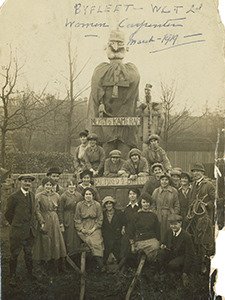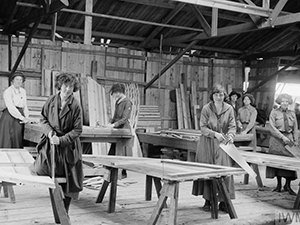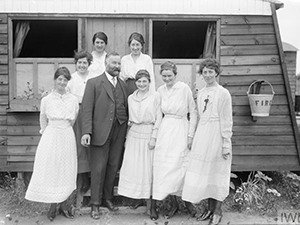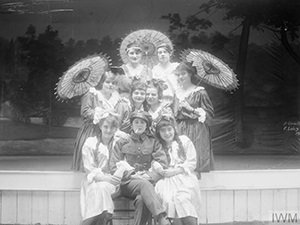 Every March, Women's History Month raises awareness of the contributions women have made to events through history and society.
Every March, Women's History Month raises awareness of the contributions women have made to events through history and society.
In November 2024, we were sent an intriguing photograph from a depositor that had belonged to her great grandfather. In it he is standing alongside a group of women workers before a large wooden effigy of the former Kaiser Wilhelm the Second and a smaller effigy of a German soldier. Both effigies wear 'iron' crosses, a sign on the Kaiser reads 'Mercy Kamerad [Comrade]' and another sign reads, 'Captured at Byfleet'. Handwritten on the photograph is 'Byfleet W.G.T. Ld. Women Carpenters. March 1919.' The depositor wondered if we could shed any further light on the picture.
It emerged that 'W.G.T. Ld' was 'W G Tarrant Limited', a building company established by Walter George Tarrant (1875 to 1942) in Byfleet in the 1890s. The company was one of the most influential and prolific housebuilders in Surrey in the early twentieth century, responsible for the development of St Georges Hill in Weybridge and the Wentworth Estate in Virginia Water. At the onset of the First World War, W G Tarrant Ltd secured government contracts to make wooden military huts for the British Army on the Western Front. Later, the company took the unusual step of employing and training women as carpenters for its hut construction projects in France.
When conscription was introduced by the Military Service Act in January 1916, it became increasingly difficult for W G Tarrant to recruit or retain skilled male employees, and the company made regular appeals to the Chertsey Rural Tribunal for workforce exemptions. As the year progressed, the company lost most of its unmarried workers and, by September, exemption certificates were being revoked for many of its married employees.
In September 1916, W G Tarrant frantically advertised for 100 carpenters and 25 good handy labourers "preferably over military age" for urgent government work in France. That year, there were also reports of Belgian and French women being trained as carpenters to help the war effort. In Britain, 'lady carpenters' were making splints and other small items for hospitals, and in May 1916, Scotland's 'Daily Record' reported that women were being employed to make slight repairs to railway carriages.
 Here, it seemed, was a solution to Tarrant's manpower woes and, by November 1916, he had obtained Government permission to recruit a female workforce, including former munitions workers, to train as carpenters. The 'Daily Express' enthusiastically, if rather patronisingly, declared, "Our women carpenters by all accounts are getting on splendidly. At the end of a month's training they will be sent out to France to build patent portable sleeping huts. The work, of course, does not call for any exceptional skill which explains the speed with which the girls are learning their work."
Here, it seemed, was a solution to Tarrant's manpower woes and, by November 1916, he had obtained Government permission to recruit a female workforce, including former munitions workers, to train as carpenters. The 'Daily Express' enthusiastically, if rather patronisingly, declared, "Our women carpenters by all accounts are getting on splendidly. At the end of a month's training they will be sent out to France to build patent portable sleeping huts. The work, of course, does not call for any exceptional skill which explains the speed with which the girls are learning their work."
National and local newspapers continued to report the progress of the 'lady carpenters' with an equal dose of enthusiasm and condescension. The 'West Surrey Times' of 18 November 1916 reported the Tribunal case of Charles Randall (37), army hut construction foreman, employed by W G Tarrant to train the women employees in rough carpentry. When Tarrant asked for exemption for Randall on the grounds of the importance of his work with the women, the Tribunal chair commented. "Well I suppose we cannot take away their schoolmaster" and granted him three months' exemption.
 Regardless, the women rose to the challenge: in January 1917, the first twenty carpenters completed their training and left for France. The 'Surrey Advertiser', 3 Feb 1917, quoted Mr Tarrant: "During the three months these women have been in training, they have become proficient in practically all kinds of general carpentry, including mortise and tenon jointing. They can now do the whole of the work in connection with hut construction except the joinery, and after another three or four months I believe they will be able to do that as well." In France, the women lived in a camp near one of the bases, run by a housekeeper-cook and a lady supervisor while, at work, their forewoman was a New Zealander whose husband was on active service.
Regardless, the women rose to the challenge: in January 1917, the first twenty carpenters completed their training and left for France. The 'Surrey Advertiser', 3 Feb 1917, quoted Mr Tarrant: "During the three months these women have been in training, they have become proficient in practically all kinds of general carpentry, including mortise and tenon jointing. They can now do the whole of the work in connection with hut construction except the joinery, and after another three or four months I believe they will be able to do that as well." In France, the women lived in a camp near one of the bases, run by a housekeeper-cook and a lady supervisor while, at work, their forewoman was a New Zealander whose husband was on active service.
According to Mr Tarrant, the women were employed on piece work earning from 25 shillings to 35 shillings a week, considerably less than their male counterparts. When concern was raised in the House of Commons in 1917 about the conditions under which the women were engaged, the Minister of Munitions replied, "The women have only been in France about a fortnight and a report will be asked for whether the work and general conditions are satisfactory. Their output and their pay is about half that of men. They do the lighter kinds of carpentry. The Munitions Act does not apply to them." Nonetheless, there was a good response to the reworked Tarrant adverts - 'Women immediately wanted for service in France' - and more women joined the ranks of carpenters.
 In January 1919, two years after the arrival of Tarrant's first women carpenters in France, the workforce returned to Britain and a warm welcome in Byfleet. According to Mr Tarrant, around 150 women had gone to work in France, constructing 37,000 huts in total and using around 50,000 pounds of nails a week. Their camp near Calais was constantly subjected to air raids but fortunately there were no casualties. In addition to their carpentry work, the women had formed an entertainment troupe which organised concerts for wounded British soldiers in France. Back in Byfleet, 'The Woodsnippers' organised a homecoming concert at Byfleet Village Hall and raised a substantial sum of money for the St Nicholas Children's Home in Pyrford. Fortuitously, newsreel footage has survived of The Woodsnippers' rehearsals outside the hall and of the women carpenters at work in France which can be viewed on the British Pathé website.
In January 1919, two years after the arrival of Tarrant's first women carpenters in France, the workforce returned to Britain and a warm welcome in Byfleet. According to Mr Tarrant, around 150 women had gone to work in France, constructing 37,000 huts in total and using around 50,000 pounds of nails a week. Their camp near Calais was constantly subjected to air raids but fortunately there were no casualties. In addition to their carpentry work, the women had formed an entertainment troupe which organised concerts for wounded British soldiers in France. Back in Byfleet, 'The Woodsnippers' organised a homecoming concert at Byfleet Village Hall and raised a substantial sum of money for the St Nicholas Children's Home in Pyrford. Fortuitously, newsreel footage has survived of The Woodsnippers' rehearsals outside the hall and of the women carpenters at work in France which can be viewed on the British Pathé website.
As for our photograph, this was taken two months after the women's return home but little more is known, so please contact us if you can provide further information. Interestingly, the 'Lancashire Evening Post' of 21 July 1919 reported a similar event in Lytham St Annes when "a cart appeared bearing an effigy of the ex-Kaiser. The hands of the figure were uplifted and there was an appeal for "Mercy Kamerad". After being 'strung up' on a gibbet on the beach, a torch was applied and the effigy was soon consumed." We can only suppose the Byfleet effigies suffered a similar fate.
As for Tarrant's 'lady carpenters', what of them? Many of the married women returned to their homes, while others, according to the West Surrey Times, 24 January 1919, were given employment in door-making or making small articles such as small tables, clothes horses, chairs and toys. It would be interesting to know how many of these women were able to continue using their new-found skills – and for how long.
Images
Select image to view a larger version.
- Women carpenters of W G Tarrant Ltd, Byfleet, standing by a large effigy of Kaiser Wilhelm II, with a 'Mercy Kamerad' sign, and a smaller effigy of a German soldier, 1919 (reference 10705/1)
- Women carpenters working at the Tarrant Hut Workshops near Calais, 30th June 1917 (Courtesy of the Imperial War Museum (IWM), reference Q 2456)
- Walter George Tarrant, inventor of Tarrant Huts, and some of the women who made 37,000 of them in a camp three miles from Calais, 30th June 1917 (Courtesy of the Imperial War Museum (IWM), reference Q 2467)
- Concert party organised by women carpenters at the Tarrant Hut Works near Calais, 3 December 1918, to give performances to wounded soldiers ((Courtesy of the Imperial War Museum (IWM), reference Q 3406)

